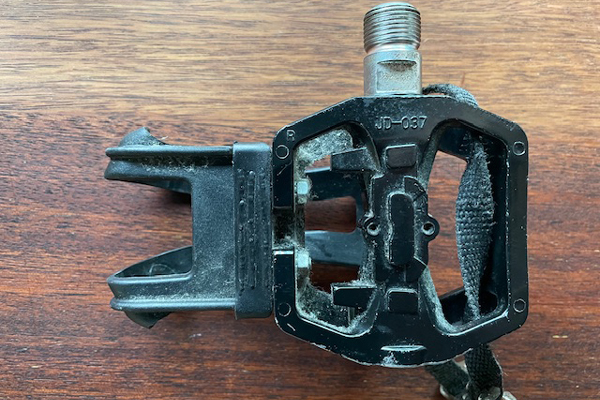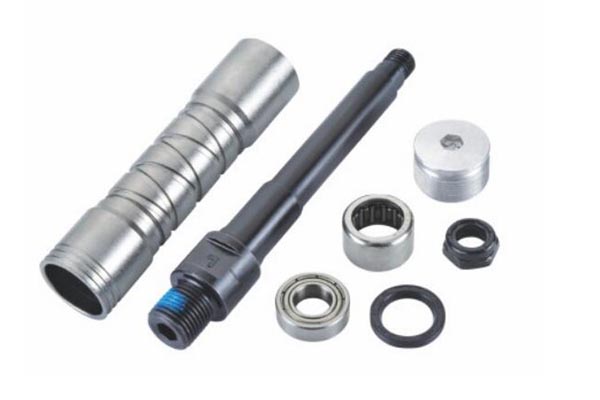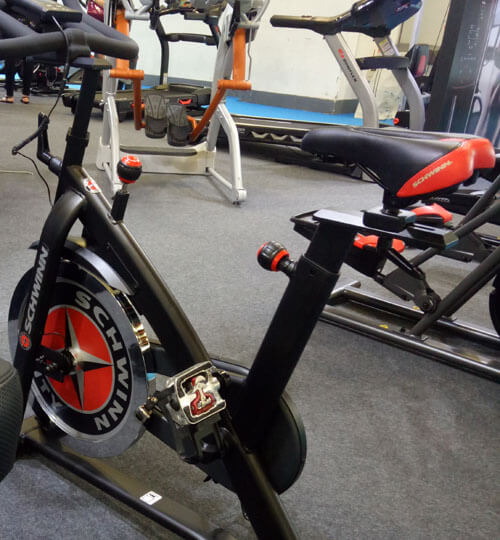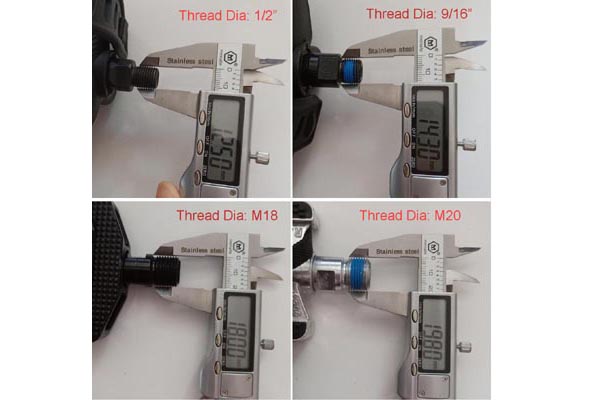OEM Fitness Parts Supply Chain – Factory-Direct, No MOQ, Global Shipping
Most exercise bikes use a standard 9/16" thread. Some older may use 1/2". If unsure, measure the thread or contact us with a photo.
Check your bike's brand and model, or measure the crank thread. You can also send us a photo — our team will identify the correct pedal for you.
Many are, but it depends on the thread size and pedal type. SPD pedals are common for spin bikes, while upright bikes may use flat pedals. We can help you match.
Not all spin bikes use SPD pedals. Some use toe cages, dual-function pedals, or other clip systems. Always confirm before ordering.
SPD pedals lock into cycling shoes with cleats for better power transfer and safety. They are commonly used in commercial spin bikes and studios.
Yes, if your crank arm uses a standard 9/16" thread. Make sure the pedal type fits your riding needs. Contact us if you're unsure.
It could be the wrong thread size or pedal type. Check left/right orientation and thread size. Still unsure? Send us a photo for support.
SPD pedals require cleated shoes and clip-in. Toe cages allow regular shoes to strap in. Some pedals offer both functions in one.
They have SPD clips on one side and flat or cage pedals on the other, ideal for shared bikes or multi-user studios.
Not directly. SPD pedals require special shoes with cleats. For regular shoes, use flat or cage pedals, or choose a dual-function pedal.
Use a pedal wrench with leverage. Remember: left pedal loosens clockwise. Apply penetrating oil if threads are seized. Contact us if unsure.
The new JD-304 version has wider SPD screw holes than the old version. If you're unsure, send us a photo to confirm your pedal type.
No problem — just send us clear photos of your pedal and crank arm. We’ll help you identify the thread and suggest a compatible option.
Yes. While we’re not officially affiliated, many of our pedals are compatible with equipment from top brands like Life Fitness, Schwinn, and more.
On average, 1–2 years with regular use. Our pedals are tested to last up to 30% longer than standard options, with reduced failure rates.
Yes. We supply commercial-grade pedals with high durability, strong axles, and reinforced bearings — ideal for heavy use environments.
Absolutely. Our engineering team can guide you through installation, compatibility, and pedal selection. Just contact us with your bike details.
Most standard models are in stock and ship within 3 days. We have no MOQ on regular items, making small batch orders easy and flexible.
Whether you're a fitness brand, OEM supplier, or gym equipment refurbisher
Shoot us a message
We’re always happy to help

It’s easy to overlook the pedals when buying or maintaining an indoor exercise bike. But the truth is, pedal quality directly affects user safety, comfort, and the lifespan of the bike itself — especially in gyms or high-use environments.
High-quality pedals improve rider safety, reduce failure rates, and extend the lifespan of exercise bikes. Poor-quality pedals often lead to breakage, injury, or costly maintenance, especially in commercial or high-use settings.Low-cost pedals may save money upfront, but they can cause bigger problems later:
For home users, good pedals mean a safer, quieter workout. For gym owners, they mean fewer repair calls and happier clients. In large fitness chains or OEM production, consistent pedal quality protects your brand and reduces return rates.
At MEYOUNG, we take this seriously. Our pedals are made with durable materials, sealed bearing options, and heat-treated axles to handle real-world use — whether it’s in your living room or a 50-bike spin class.
Want pedals that last longer and perform better? Talk to us today or explore our full range of exercise bike components.

Choosing the correct exercise bike pedal—SPD, dual-function, or flat—depends on your user base and the equipment’s usage environment. Whether for home workouts, commercial gyms, or rehabilitation centers, pedal selection impacts safety, comfort, and training efficiency.
For home use, plastic pedals with ball bearings are ideal. Spin bikes in clubs need durable aluminum pedals with sealed bearings. Rehab centers require large, anti-slip plastic pedals with straps and heel support.| User Group | Recommended Pedal Type | Key Features |
|---|---|---|
| Home | Plastic pedal with steel ball bearings | Lightweight, budget-friendly, low maintenance |
| Gym / Club | Aluminum pedal with sealed bearings | Durable, corrosion-resistant, low noise |
| Rehabilitation | Plastic pedal with heel support and anti-slip texture | Wide surface, secure straps, safety-focused |
| Pedal Type | Best For | Main Features |
|---|---|---|
| Flat Pedal | Casual home use, rehab | Non-slip, wide surface, usable with any shoes |
| SPD Pedal (Clipless) | Professional cycling, fitness studios | Requires cycling shoes, better energy transfer |
| Dual-Function Pedal | Gyms, mixed user groups | SPD clip on one side, toe cage on the other |
For procurement teams serving a range of clients—from home fitness to professional studios—it’s essential to match pedal type to the rider’s skill level and shoe type. Dual-function pedals are the most versatile choice, reducing equipment turnover and increasing user satisfaction. MEYOUNG offers all three pedal types, tested for durability and comfort across different use cases.
Contact us to get matched with the best pedal configuration for your clients.

Pedals are one of the most frequently used components on an exercise bike. Over time, they wear out and can pose safety risks or reduce workout performance. Knowing when to replace them helps maintain user safety and avoid costly damage to crank arms.
Replace exercise bike pedals if they show signs of cracking, loose rotation, noisy bearings, stripped threads, or unresponsive clip mechanisms. Regular inspection ensures rider safety and optimal equipment function.
– Home Use: Every 6 months or 1,000 km of use
– Commercial Gym Use: Monthly, especially for high-traffic spin studios
– Rehabilitation Centers: Every 3 months due to patient-specific motion and safety needs
The following table provides general guidelines for MEYOUNG pedal replacement based on bike type, usage environment, and bearing system:
| Bike Type | Usage | Bearing System | Estimated Replacement Interval |
|---|---|---|---|
| Upright/Recumbent Bike | Home | Ball Bearing | 1–2 years |
| Upright/Recumbent Bike | Home | Sealed Bearing | 1.5–2.5 years |
| Upright/Recumbent Bike | Gym | Ball Bearing | 8 months–1 year |
| Upright/Recumbent Bike | Gym | Sealed Bearing | 1–1.5 years |
| Spin Bike | Home | Ball Bearing | 6 months–1 year |
| Spin Bike | Home | Sealed Bearing | 1–1.5 years |
| Spin Bike | Gym | Ball Bearing | 3–6 months |
| Spin Bike | Gym | Sealed Bearing | 6 months–1 year |
| Elliptical Bike | Home | Ball Bearing | 1–1.5 years |
| Elliptical Bike | Home | Sealed Bearing | 1.5–2 years |
| Elliptical Bike | Gym | Ball Bearing | 6 months–1 year |
| Elliptical Bike | Gym | Sealed Bearing | 8 months–1.5 years |
These timelines are general estimates and can vary based on rider weight, frequency of use, and maintenance practices.
Need help selecting the right replacement pedal? Email our experts or visit our product catalog.

If you’ve ever had a pedal that started feeling rough or making strange noises, chances are it’s got something to do with the bearings inside. Most indoor bike pedals come with either steel ball bearings or sealed cartridge bearings — and the difference between the two is bigger than you might think.
Indoor exercise bike pedals use steel ball or sealed cartridge bearings. Sealed bearings last longer and need less care, while ball bearings are cheaper but wear out faster and need regular maintenance.| Feature | Steel Ball Bearings | Sealed Cartridge Bearings |
|---|---|---|
| Maintenance | Needs regular greasing and tightening | No maintenance needed — totally sealed |
| Durability | Wears out quicker, especially in busy gyms | Lasts longer, even under heavy use |
| Ride Feel | Can get rough or noisy over time | Stays smooth and quiet |
| Cost | Lower upfront price | Costs a bit more, but lasts longer |
| Best For | Home bikes, light use | Spin classes, clubs, heavy-duty use |
Bearings are important, sure. But there’s another part of the pedal that really matters too — the axle (or spindle). That’s the piece that holds the pedal together and connects it to the bike. If it snaps? That’s game over for your ride.
That’s why at MEYOUNG, we go the extra mile. We put our axles through a multi-step heat treatment process. That means they’re tough — not just “won’t break easily” tough, but “can handle serious pressure” tough. If the force gets extreme, they bend instead of snapping. That’s a big deal when it comes to rider safety and pedal life.
If you’re just riding casually at home, ball bearings might do the trick. But for gyms, spin studios, or anyone who doesn’t want to deal with squeaky pedals down the road, sealed bearings and treated axles are the way to go.
Still not sure which type fits your needs? Shoot us a message — we’re always happy to help you figure it out.

Our pedals are compatible with a wide range of fitness equipment used in both home and commercial settings. They can be used as replacements for pedals originally installed on equipment from globally recognized fitness brands, including but not limited to:
- Life Fitness
- Matrix
- Schwinn
- Star Trac
- Technogym
- Concept2
- Precor
- NordicTrack
- Sunny Health & Fitness
- Echelon
- Impulse
- and other major commercial and home fitness brands.
If you’re unsure about compatibility, simply send us a photo or model number of your equipment — we’ll help you match the right part.
All product and company names are trademarks™ or registered® trademarks of their respective holders. Use of them does not imply any affiliation with or endorsement by them. Our parts are compatible replacements, not original manufacturer parts unless clearly stated.

Not all exercise bike pedals are interchangeable. One of the most important but often overlooked details is the pedal thread size. Choosing the correct thread type ensures a secure fit, protects the crank arm, and avoids costly mistakes during replacement or assembly.
The most common pedal thread sizes are 9/16", 1/2", 5/8", M16, M18, and M20. Pedals are not universally compatible — thread size and bike type must match to avoid damage or fitting issues.| Thread Size | Thread Type | Typical Application |
|---|---|---|
| 9/16″ (20 TPI) | BC/UNF | Most spin bikes, upright bikes, recumbent bikes |
| 1/2″ (20 TPI) | UNF | Low-end home bikes, mini exercisers |
| 5/8″-18 | UNF | Some OEM or older European models |
| M16 x 1.5 | Metric | Some OEM or older European models |
| M18 x 1.5 | Metric | Occasional use in commercial bikes |
| M20 x 1.5 | Metric | Heavy-duty or spin bikes with large cranks |
| 5/16″, 3/8″ | UNF | Custom or rare cases |
Use a caliper to measure:
Always match the thread on the pedal to the crank arm. Forcing the wrong size can strip the threads or make the pedal unsafe.
No, pedal compatibility depends on the crank arm thread size. A 9/16” pedal won’t fit a 1/2” crank, and forcing the wrong type can strip the threads. Even within 9/16”, differences in machining quality can affect installation.
Plastic pedals are typically found with 9/16” or 1/2” threads and used on upright or mini bikes. Aluminum pedals often use 9/16”, M18, or M20 threads, especially for spin bikes. Rare sizes like 5/8″, 5/16″ or 3/8″ are usually custom-made or specific to certain OEM brands.
At MEYOUNG, we stock a wide range of thread types and help clients match pedal threads with bike models accurately — saving time and avoiding installation errors.
Not sure what thread your bike uses? Send us a photo or part number, and we’ll help you confirm compatibility within 24 hours.
We will get back to you within one business day.
We will get back to you within one business day.